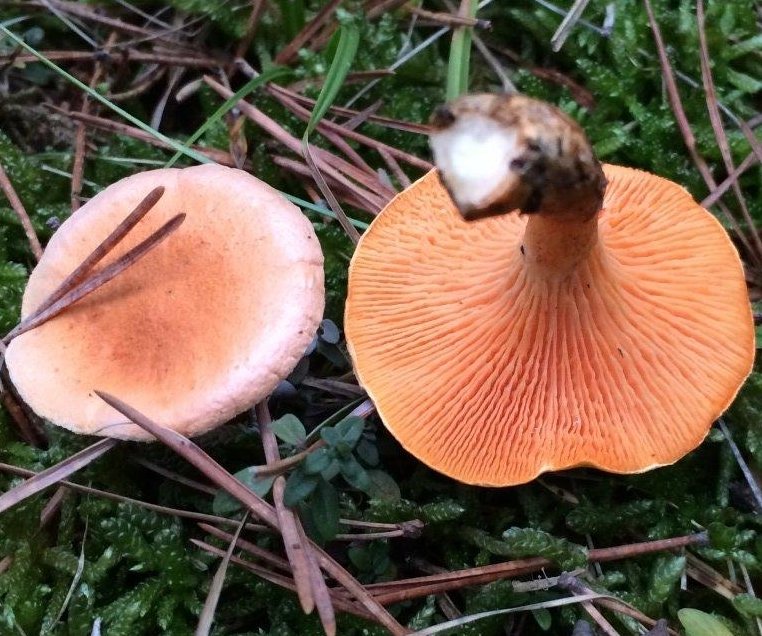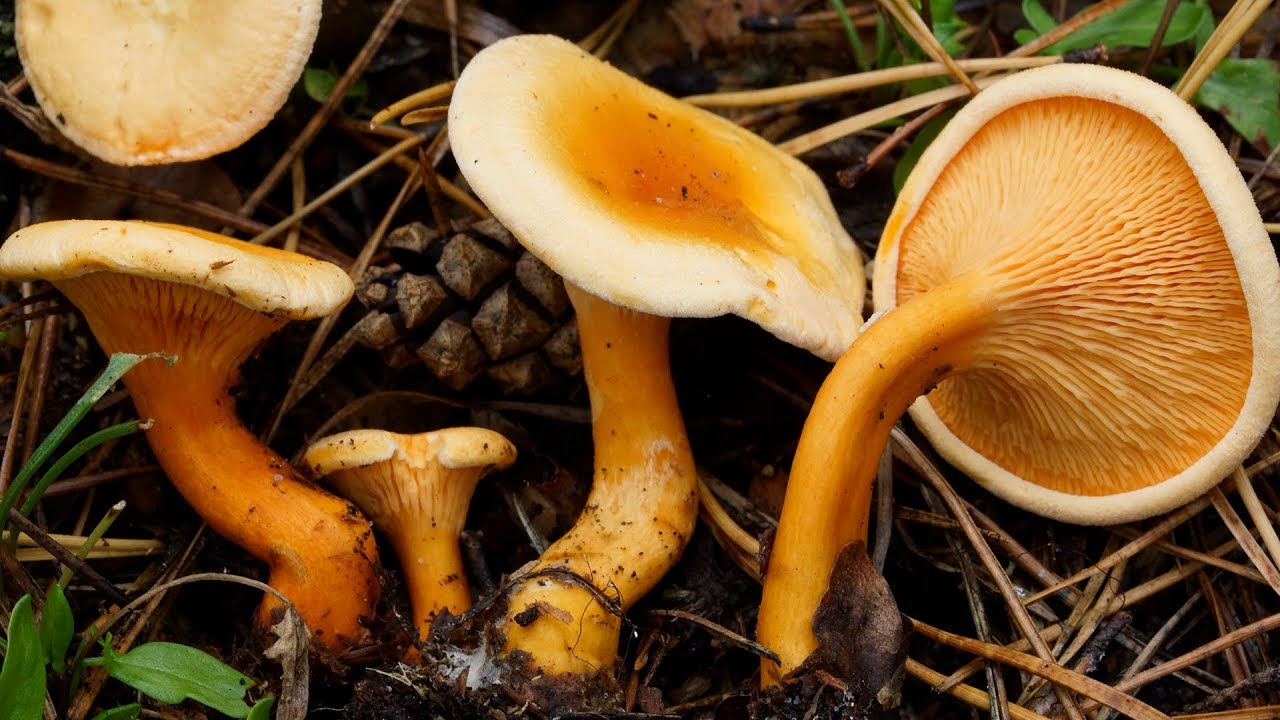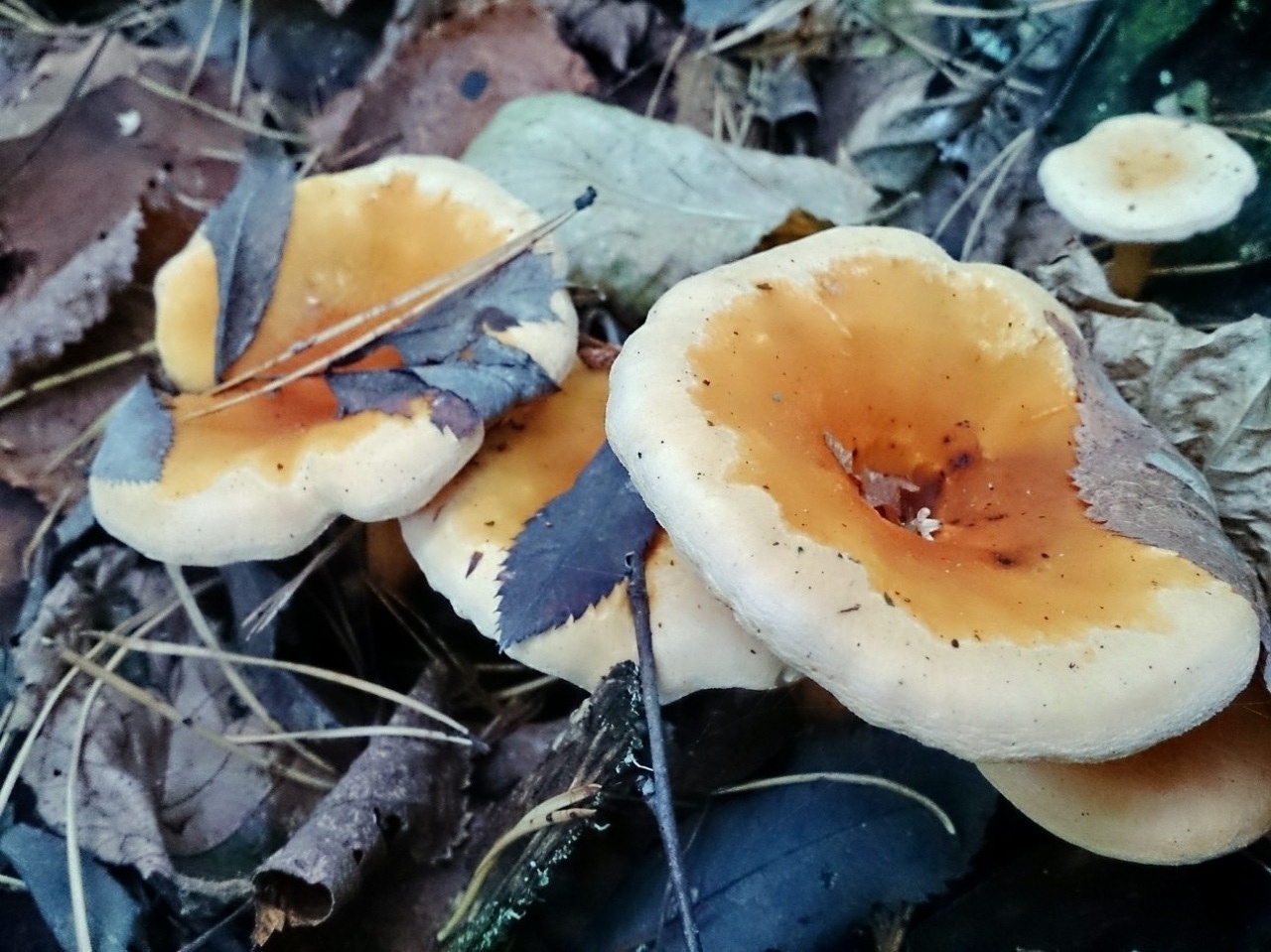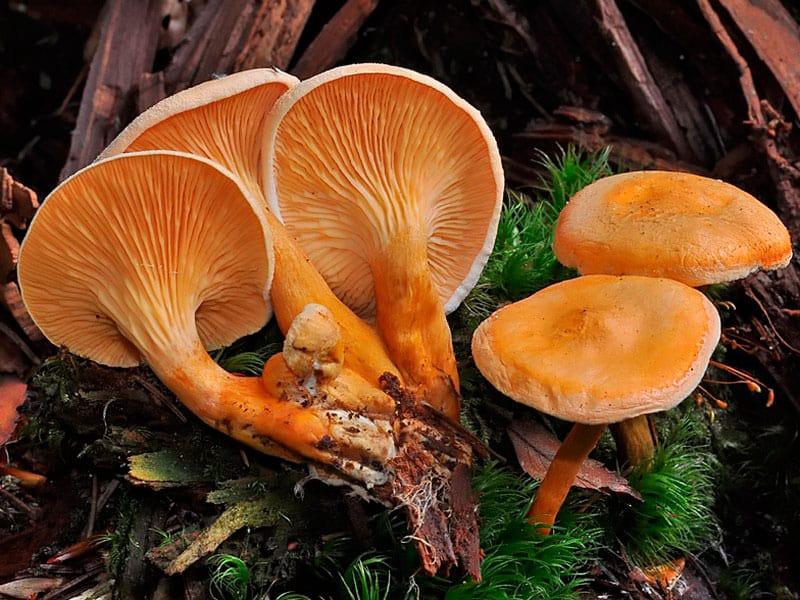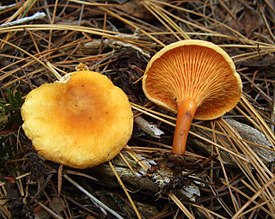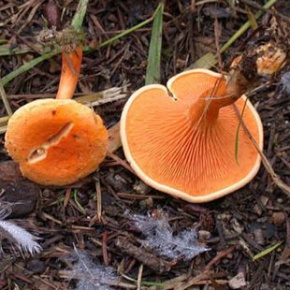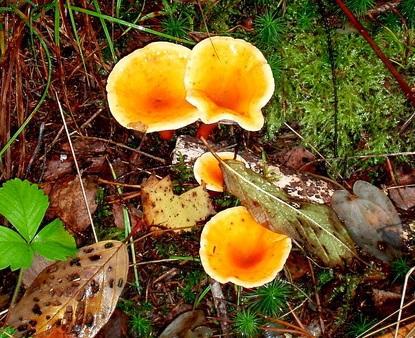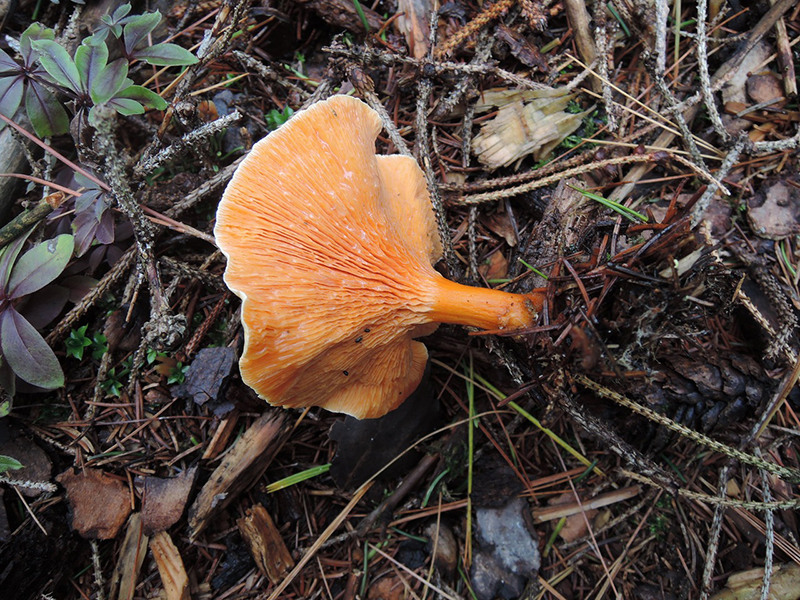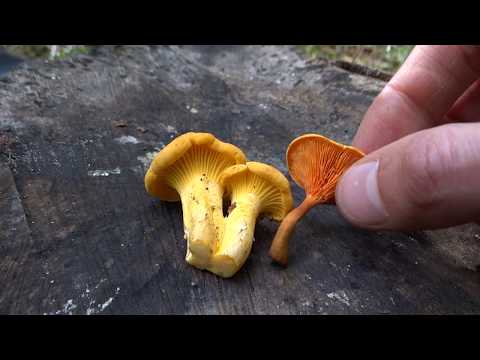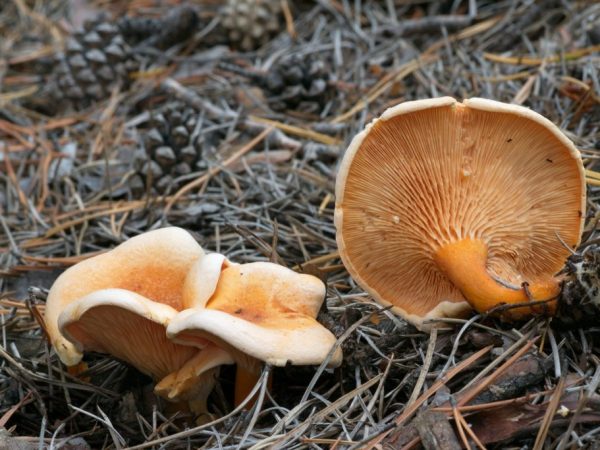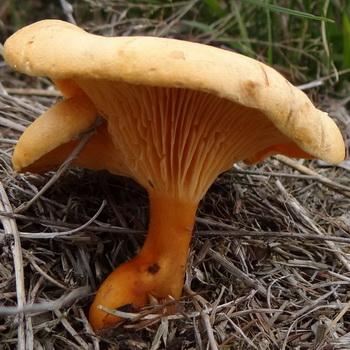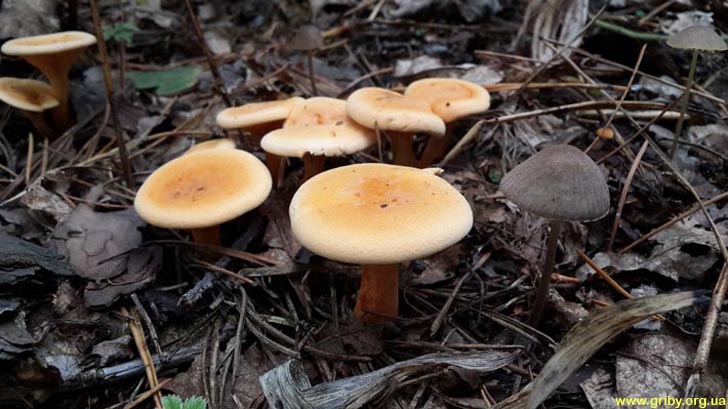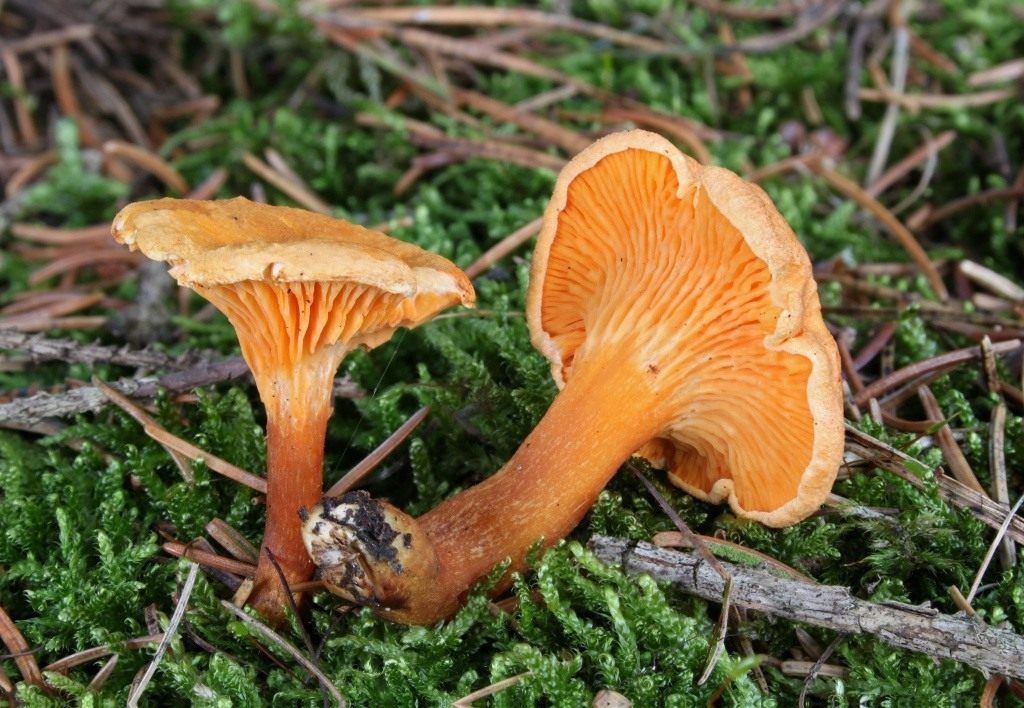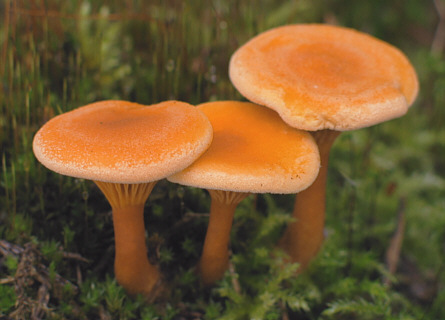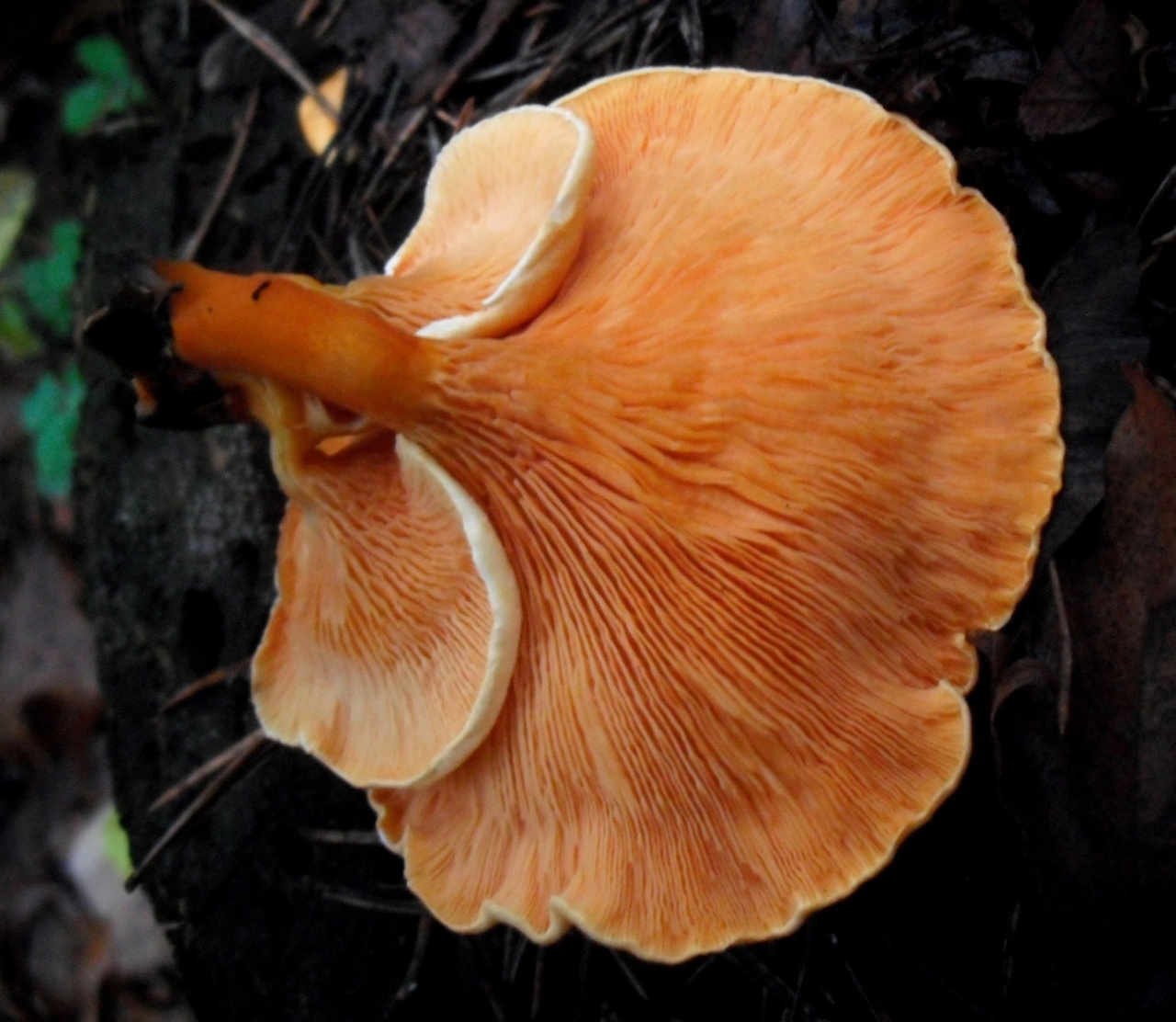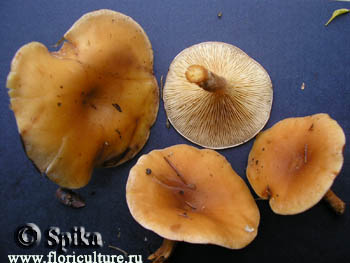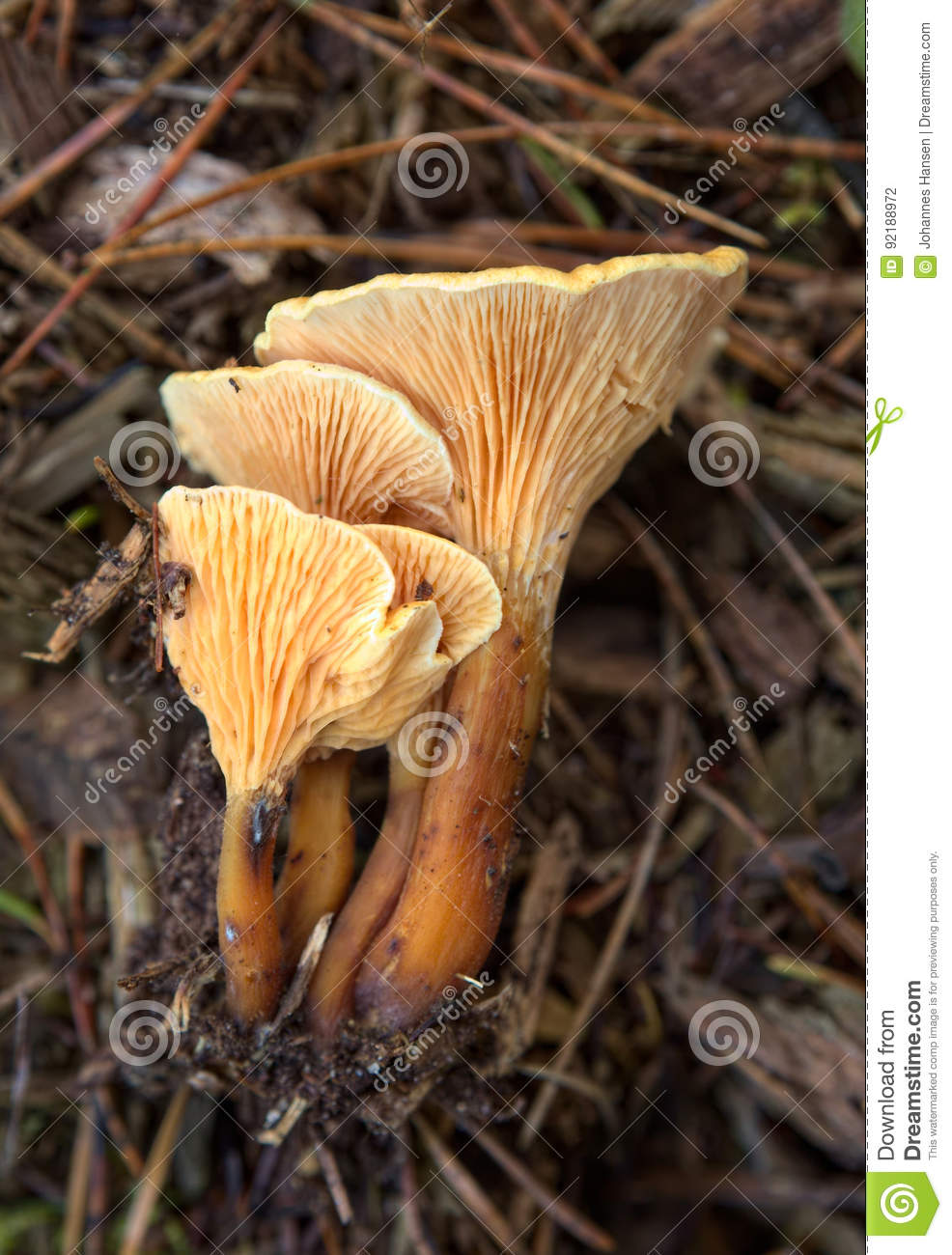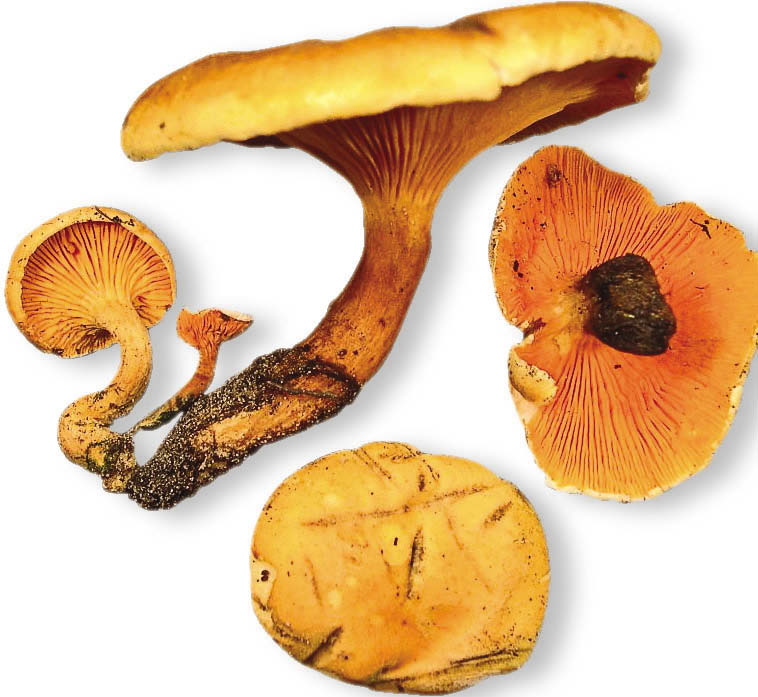Definitioner
- Basidia (Basidia)
-
Lat. Basidia. A specialized structure of sexual reproduction in fungi, inherent only in Basidiomycetes. Basidia are terminal (end) elements of hyphae of various shapes and sizes, on which spores develop exogenously (outside).
Basidia are diverse in structure and method of attachment to hyphae.
According to the position relative to the axis of the hypha, to which they are attached, three types of basidia are distinguished:
Apical basidia are formed from the terminal cell of the hypha and are located parallel to its axis.
Pleurobasidia are formed from lateral processes and are located perpendicular to the axis of the hypha, which continues to grow and can form new processes with basidia.
Subasidia are formed from a lateral process, turned perpendicular to the axis of the hypha, which, after the formation of one basidium, stops its growth.
Based on morphology:
Holobasidia - unicellular basidia, not divided by septa (see Fig. A, D.).
Phragmobasidia are divided by transverse or vertical septa, usually into four cells (see Fig. B, C).
By type of development:
Heterobasidia consists of two parts - hypobasidia and epibasidia developing from it, with or without partitions (see Fig. C, B) (see Fig. D).
Homobasidia is not divided into hypo- and epibasidia and in all cases is considered holobasidia (Fig. A).
Basidia is the place of karyogamy, meiosis and the formation of basidiospores. Homobasidia, as a rule, is not functionally divided, and meiosis follows karyogamy in it. However, basidia can be divided into probasidia - the site of karyogamy and metabasidia - the site of meiosis. Probasidium is often a dormant spore, for example in rust fungi. In such cases, probazidia grows with metabasidia, in which meiosis occurs and on which basidiospores are formed (see Fig. E).
See Karyogamy, Meiosis, Gifa.
- Pileipellis
-
Lat. Pileipellis, skin - differentiated surface layer of the cap of agaricoid basidiomycetes. The structure of the skin in most cases differs from the inner flesh of the cap and may have a different structure. The structural features of pileipellis are often used as diagnostic features in descriptions of fungi species.
According to their structure, they are divided into four main types: cutis, trichoderma, hymeniderma and epithelium.
See Agaricoid fungi, Basidiomycete, Cutis, Trichoderma, Gimeniderm, Epithelium.
- Cutis
-
The type of cap skin, consists of creeping non-gelatinized hyphae located parallel to the surface. The surface of the cap looks smooth.
Lat. Cutis.
See Gifa.
Chanterelle-like orange mushrooms. Description of the chanterelle mushroom: cap, leg and plates
Check out the photo and description of what chanterelle mushrooms look like and what are their distinctive features.
Signs of a yellow plate consist of a light orange cap, similar in color to an egg yolk, however, sometimes a darker yellow yolk, and sometimes whitish. The surface of the cap is naked and oily, and its width varies from 2 to 7 cm.
In young chanterelle mushrooms, the cap is convex, almost spherical, while in old ones it is very concave, glass-like, with the edges bent down, somewhat hairy and always excised behind the plates on the cap. The older the mushroom, the more pronounced this excision and the more hairs appear on the edges.
The plates of a yellow chanterelle are as thick as a thick sheet of paper, and reach almost 0.5 cm in width.They are located in close rows, the colors are always the same - light yellowish, and the longest of them go onto the leg and, going down it pretty far, disappear imperceptibly. In young mushrooms, the plates are single, parallel, and the older the mushroom, the more branching they become, especially along the edge of the cap, where two or even three branches are separated, so that even the mushroom itself looks like a sinewy net.
Look at the photo of what the chanterelles look like: the leg of the yellow plate is from 2 to 5 cm high, and from 0.5 to 1 cm thick, it is flat throughout its entire length, but gradually begins to expand towards the cap, and, getting lost in the plates lowered onto it , it takes on the appearance as if the hat constitutes its continuation. In young mushrooms, the leg is solid, subsequently it forms an irregular cavity inside. In general, it is fleshy, hard and smooth, although it always looks from a distance, as if covered with frost, of the same color as the cap. In deciduous forests, this mushroom is very large.
Characteristics and description of the inedible mushroom
Orange talker, or false chanterelle (Higrophoropsis aurantiaca), is a mushroom of the Higrophoropsidaceae family.
Scientific classification: department - Basidiomycetes, class - Agaricomycetes, order - Boletaceae, family - Gigroforopsis, genus - Gigroforopsis, species - Gigroforopsis orange.
International scientific name: Hygrophoropsis aurantiaca (Wulfen) Maire, 1921.
Other names: false chanterelle, bent talker, orange Gigroforopsis, kokoshka.
Latin names: Hygrophoropsis aurantiaca, Agaricus aurantiacus, Merulius aurantiacus, Cantharellus aurantiacus, Clitocybe aurantiaca, Agaricus alectorolophoides, Agaricus subcantharellus, Cantharellus brachypodus.
Hat
It is small, with a diameter of 2 to 5 cm. In only sprouted mushrooms, it is first convex, with a curved edge, then flat-spread, with a depression in the center, in the form of a funnel with a curved and straight thin edge. The color of the cap is orange- or yellow-ocher, fading to pale yellowish with a bright lemon center and a whitish edge during the growing season. It is smooth and pleasant to the touch.
Hymenophore
This is the lower part of the cap containing a thin spore-bearing layer. The surface of the hymenophore is highly developed, which allows it to produce a large number of spores. The type of this part of the fruiting body is important both in determining the families of fungi and in identifying species of the same genus.
The plates of the hymenophore of the orange talker are folded, often arranged, thick, descending (descending from the cap to the leg). Bright yellow-orange color, turn brown when pressed with fingers. When the fruiting body is fully ripe, a white spore powder is formed in the hymeniums of the fungus.
Cut pulp
In the center of the cap it is thick, closer to the edges it is thin, rather dense, with age it acquires a cotton-like structure of yellow color. In the leg it is always tight, hard, reddish.
Leg
Thin, 3 to 6 centimeters long. In diameter - up to 1 cm, cylindrical, tapering towards the base. Bright yellow-orange color, like the records. The bottom of the leg is always darker. Depending on the type of soil (if it is dense), it can bend at the base. In young mushrooms, the inner part of the stem is solid, becoming hollow with age.
A bit of history
The false chanterelle was first described by the Austrian naturalist Franz Xaver von Wulfen in 1781. He noted its similarity to the real one and the fact that mushroom pickers often confuse these two species. Later, in 1900, the French botanist and mycologist Rene Charles Joseph Maire identified the false chanterelle as a talker (Clitocybe). Together with the adjective "orange", this became its second name.
Poisonous mushrooms that look like chanterelles. The chanterelle is false and its difference from the real chanterelle
False chanterelle - a mushroom that resembles a real chanterelle, but in fact is not related to it. Previously, false chanterelles were classified as poisonous mushrooms, but now they have been assigned the category of conditionally edible mushrooms.
In many foreign publications, these mushrooms are classified as edible, but it is noted that they have a lower taste in comparison with ordinary chanterelles.
In everyday life, a false chanterelle is called a kokoshka.
With proper culinary processing of these mushrooms, poisoning does not threaten, but in case of problems with the digestive system, a feeling of heaviness is possible, therefore they are not recommended to be consumed.
Description of false chanterelle
The false chanterelle has a brighter color in comparison with the real chanterelle.Its color is most often orange with a brown tint, the edges are always lighter than the center. The surface of the cap is velvet.
The color of the cap of a real chanterelle is light yellow, sometimes it can be almost white, but it can reach yellow-orange. A real chanterelle can never be as red as its counterpart.
In addition, the color is the same both in the central part and at the edges, and the surface is smooth.
The edges of the caps of the false chanterelles are smooth, neatly rounded. The diameter of the cap does not exceed 3-6 centimeters. In young mushrooms, the shape of the cap is slightly convex, while in mature it becomes funnel-shaped. The edges of the caps of real chanterelles are wavy, their shape is irregular. The diameter of the cap can be up to 12 centimeters. In young true chanterelles, the cap is convex in shape, then becomes flat.
The plates of false chanterelles are thin, often located, not passing to the stem, branching, orange in color. And in real chanterelles, the plates are denser, they go down to the leg.
The flesh of false chanterelles is yellow, friable, tasteless with an unpleasant odor. If you press on the pulp, its color remains the same. In true chanterelles, the flesh is white in the middle, and yellowish at the edges, its taste is sour and has a pleasant aroma.
False chanterelles have thin, red-orange legs. In adult specimens, the legs are hollow. In the lower part, the color of the leg is darker. The shape is cylindrical. The cap is clearly separated from the leg. In real chanterelles, the legs are not hollow, they are thicker, there is no distinction with the cap, dense, smooth, narrowed downwards, of the same color as the cap. In false chanterelles, the color of the spores is white, while in the real ones it is yellow.
Where do false chanterelles grow?
These mushrooms can be found in mixed and coniferous forests. They are found on decaying wood, in moss, among dead wood. Yields peak from summer to autumn. False chanterelles can grow singly and in groups. Real chanterelles also grow in forests, but they do not inhabit old trees.
False chanterelles often grow in the neighborhood of real chanterelles.
Another difference between these similar mushrooms is that worms never start in real chanterelles, which is due to the content of chitinmannose in their composition. This substance has an anthelmintic effect.
Insect larvae die under the influence of this substance. In false chanterelles, chitinmannosis is not produced, so their fruiting bodies can be affected by worms.
Are False Chanterelles Poisonous or Not?
False chanterelles can be eaten, but they are not particularly tasty mushrooms. Like other conditionally edible mushrooms, false chanterelles need preliminary soaking for 3 days. In this case, in the morning and in the evening, the water must be replaced with a new one. After soaking, the mushrooms are boiled for 15 minutes. The false chanterelles can then be marinated or fried.
As a rule, experienced mushroom pickers do not pay attention to false faces, since more delicious mushrooms grow in the forest at this time. It should be remembered that in people with a weak digestive system, the use of false chanterelles can provoke a violation of the digestive process
With improper culinary processing of false chanterelles, signs of poisoning appear: nausea, dizziness, vomiting, weakness, upset stools, abdominal pain and cramps. With these symptoms, you should immediately call an ambulance.
Chanterelle mushroom drawing. We draw chanterelle mushrooms with a simple pencil. Master class with step by step photos
Dina Fomina We draw chanterelle mushrooms with a simple pencil. Master class with step by step photos
We draw chanterelles with a simple pencil. Master class with step by step photos.
The purpose of the master class: to learn how to draw mushrooms with a simple pencil
Equipment, materials: simple pencils of different softness, eraser.

Many, taking on a drawing, begin to draw from a certain part of the object (from the face of a person, from the head of an animal). Because of this, the drawing turns out to be disproportionate, it shifts in relation to other objects in the drawing, sometimes it is possible not to calculate and then the object does not fit entirely on the sheet at all.To prevent this from happening, you need to remember the rule - we draw from the general to the particular. That is, first, the general outline of the object is drawn, its location, and then on top of the general outline, particular details are drawn. Therefore, first we select the general contours of our chanterelles, determine how they will lie in relation to each other. Using this rule, our objects in the figure will not "scatter" on the sheet in different directions and will be correctly proportioned.
Now you can draw the outline of the mushrooms.

Pay attention to how the folds on the mushroom cap are located

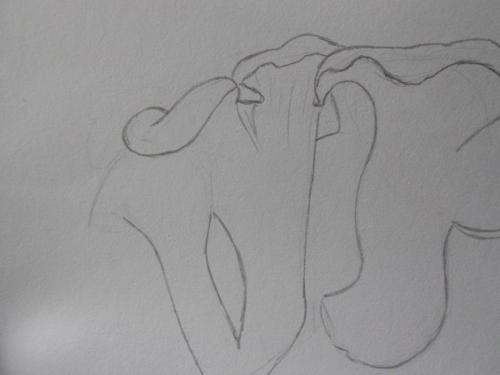
Now let's mark where the shadows on the mushrooms will be. Our shadows cast the hats on the legs. There will also be shadows on the folds and on the sides of the legs. Shading all the shadows.
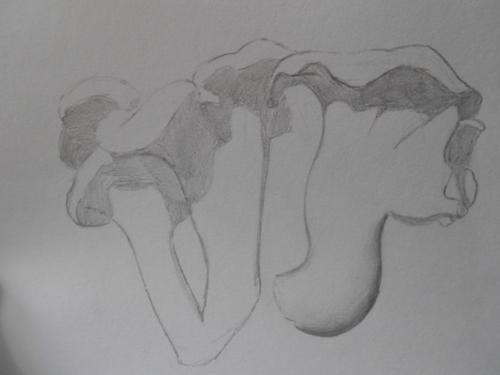
The mushroom is not a flat object, so we see a shadow on the edge of its leg.
Please note that such a shadow is not sharp, it smoothly and imperceptibly passes from darker to light. So we apply it with a pencil, increasing the pressure from the edge and weakening in the middle of the mushroom leg
This is called a transition.
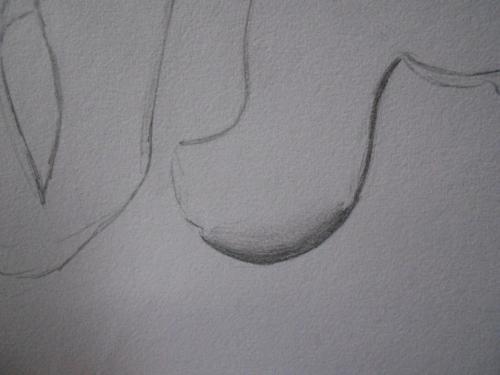
Now you can draw the contours more clearly and proceed to the folds under the mushroom head. We draw dark lines. Note that they are not even, of different lengths and shapes, darker under the cap and light and barely noticeable at the leg, in the place where they end.

On the convex parts, the folds repeat the rounded shape of the mushroom.
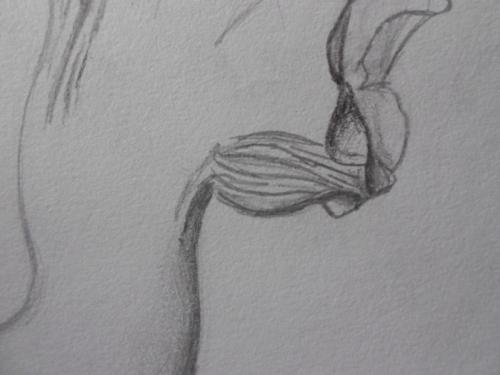
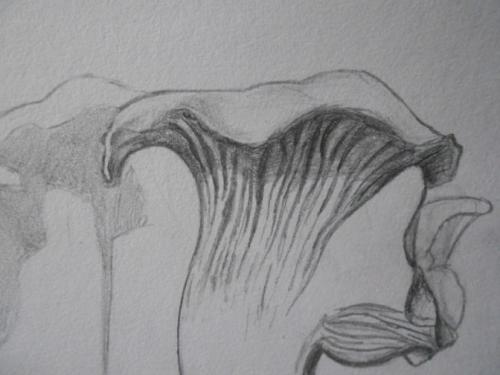
Increase the shadow under the hat.

Ready. Now we draw the ground and sticks on the mushroom legs with arbitrary strokes.
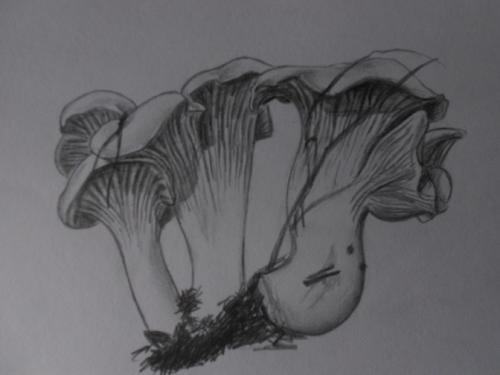
Comparison of real and false chanterelles
Every lover of collecting forest gifts should know what a false chanterelle looks like. To determine the differences, it is necessary to familiarize yourself in detail with each of the types. Such varieties of chanterelles as tubular, gray, white and others do not have twins, but an ordinary cockerel can be confused with an orange talker.
The chanterelle is real
False chanterelle
Despite the fact that edible and false specimens are very similar, an experienced mushroom picker can easily tell them apart. This is where a simple tip from a seasoned forest lover comes in handy. Despite the fact that these are delicious mushrooms, it should be remembered that they have counterparts. I'll tell you how I define chanterelles: you can focus on the color of their hats and the shape of their legs. So, everyone's favorite bettas are distinguished by a muted reddish color.
The surface of their cap is matte, always smooth, the skin almost does not separate from the pulp - thick, juicy, corresponding to the shade of the leg. Sometimes the flesh of the mushroom can be very light, almost white. When broken and pressed, it turns slightly red.
The edges of the cap at a young age are smooth, neatly rounded. As they grow, they bend beautifully, become wavy at the edges, and the fruit body acquires a slightly funnel-shaped shape with a deepened center.
A real chanterelle is capable of growing to a large size. Often there are specimens with a cap diameter of about 10-12 cm.
Chanterelle mushrooms have a thick and strong stem. It expands at the top and merges smoothly into the cap. The color of the fruiting body does not change throughout, it is uniform. The leg thickness is from 10 to 30 mm, the length is up to 7 cm. It is slightly lighter than the cap.
Males do not have plates, the hymenophore consists of frequent, highly branched folds that descend to the pedicle, making up one whole with it.
The color of the caps of the false chanterelle is brighter than that of the real ones. So, when collecting gifts from the forest, the mushroom picker should be alerted by the yellow or orange, slightly velvety surface of the specimen encountered. The diameter of the cap of the kokoschka does not exceed 6 cm, the plates descend to the stem. They are frequent, thin, bright. The pulp is white or yellow, with a sharp mushroom odor (if the aroma is sweetish, then this also indicates that the specimen belongs to the genus Gigroforopsis).
A pronounced difference between these mushrooms is that they have a rather thin (up to 10 mm) and long (up to 5 cm) stem. It is flat, but rarely curved. Inside - fibrous, with pulp resembling cotton wool. The color of the flesh of the leg does not match the shade of the cap; at the base it is darker (almost black).
Key differences
So, you need to remember the difference between representatives of two types of eukaryotes. They are as follows:
- False chanterelles have a brighter color. Cockerels have a calm reddish tone.
- If the mushroom has a sour taste, and its leg is thick and smoothly turning into a cap, then this is an ordinary chanterelle. Such a mushroom has a slightly curved leg shape. Kokoschki have a thin and hollow stem.
- The chanterelle mushroom grows in large colonies, the kokoshka - almost always single specimens. It can be found on fallen and rotting tree trunks.
- All kinds of worms and larvae are very fond of eating false chanterelles, while cockerels are extremely rarely spoiled by insects. The only worm that can be found when cutting the fruit body of a cockerel is the wireworm. This fact is explained by the presence in the fruiting bodies of common chanterelles of a large amount of chitinmannose.
- Another difference is that false eukaryotes have an easily peelable skin. When it is removed, the rough surface of the cap is exposed. It is almost impossible to remove the skin of the cockerels.
- In orange talkers, the color of the plates is brighter than the tone of the cap, while in roosters it is uniform and uniform over the entire surface.
These are the main characteristics that show how one species differs from another.
Mushrooms are false chanterelles, as the people call it. Forest gold: why chanterelle mushrooms got such a name
Elegant, bright and some extremely positive mushrooms are really associated with the forest fur-bearing animal. But the chanterelle mushrooms, rich in vitamin C and carotene, were not named after the fox. Or rather, not only because of this.
Few stories about chanterelles
These mushrooms have been known for a very long time. Roman patricians also feasted on dishes of chanterelles. The French aristocrats greatly appreciated the delicacy. And among the Normans, it was believed that bright yellow mushrooms contribute to the strengthening of masculine strength, so they were an obligatory attribute of the wedding table for newlyweds. The official description of chanterelles was first given by Carl Linnaeus. It happened in 1753. The mushroom was named Agaricus chantarellus, which means real or common chanterelle. In the 20s of the next century, the description of the mushroom was given by the Swedish biologist and mycologist E. Fries - Cantharellus cibarius. The first word is translated as "edible", and the second, most likely, meant a small wine bowl, since the mushroom cap is really something like a goblet or funnel.
"Fox" animals and mushrooms
In Russia, the word "fox" existed. If we use an analogy with the words of the modern Russian language, then it means "yellow". The forest cheat fox probably also owes its name to this word due to the color of the fur coat - yellow or red.
ordinary;
gray;
velvety;
cinnabar red;
faceted;
yellowing;
tubular.
Why are chanterelles useful?
The unusual color of these mushrooms is due to the high levels of beta-carotene. There is no less of it in chanterelles than in carrots or persimmons. This variety of mushrooms is especially valuable and useful due to the polysaccharides present in the composition:
hatinmannoza. It is a natural anthelmintic that allows you to get rid of parasites;
ergosterol. It is a substance that has a positive effect on liver enzymes;
trametonolinic acid, which has antiviral effect.
There are practically no worms in edible chanterelles. This is due precisely to the presence of chitinmannose in the composition, which is fatal to arthropods and helminths. When their eggs get into the flesh of the mushroom, they are completely destroyed, preventing the appearance of the worm.Therefore, the proximity with chanterelles is useful for other representatives of the mushroom kingdom. For example, if chanterelles grow next to porcini mushrooms, which are a favorite delicacy of not only people, but also parasites, then few insects will dare to sit on the boletus and spoil it.
What is another name for chanterelle mushrooms
We can also hear the name of the mushroom as cockerel. Probably, the chanterelles got it for the wavy edge of the cap, reminiscent of a cock's comb. Slightly less common is the name sploen (from fr.gather in frills, fold in folds) In most foreign countries, the name of chanterelles is a derivative of the Latin name. So, in Great Britain, France and Norway it is chanterelle, and in Denmark it is kantarel. In addition to the official name, chanterelles also have nicknames. For example, in Germany the mushroom is called "real cheat" (Echter Pfifferling), and also egg, and the inhabitants of Japan respectfully call it a yolk-colored mushroom.
How to cook chanterelles
You can cook almost anything your heart desires from these mushrooms. They make an excellent cream soup, a luxurious roast in sour cream, casseroles, salads. Chanterelles are combined with fried potatoes, rice, pasta. They are used in the preparation of unusual pilaf and for baking wonderful pies. The taste of the dish is determined by the freshness of this component. It is not recommended to store mushrooms for a long time, because over time they acquire an unpleasant bitterness. You can store them for future use: boil in salted water for 20 minutes, drain the liquid and freeze. Such a preparation will not lose taste, aroma and benefit after defrosting. Eating dishes from chanterelles has a beneficial effect on the condition of the eyes and mucous membranes, improves the condition of the skin, normalizes liver function, and increases efficiency. Mushroom dishes are not recommended for people suffering from gastrointestinal diseases and children under the age of 8 years.





